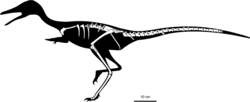
Parvicursor is a genus of tiny maniraptoran dinosaur with long slender legs for fast running.

Deinocheirus is a genus of large ornithomimosaur that lived during the Late Cretaceous around 70 million years ago. In 1965, a pair of large arms, shoulder girdles, and a few other bones of a new dinosaur were first discovered in the Nemegt Formation of Mongolia. In 1970, this specimen became the holotype of the only species within the genus, Deinocheirus mirificus; the genus name is Greek for "horrible hand". No further remains were discovered for almost fifty years, and its nature remained a mystery. Two more complete specimens were described in 2014, which shed light on many aspects of the animal. Parts of these new specimens had been looted from Mongolia some years before, but were repatriated in 2014.

Adasaurus is a genus of dromaeosaurid dinosaur that lived in Asia during the Late Cretaceous period about 70 million years ago. The genus is known from two partial specimens found in the Nemegt Formation of Mongolia that were partially described in 1983 by the paleontologist Rinchen Barsbold.

Nomingia is a genus of oviraptorosaur theropod dinosaur hailing from the Late Cretaceous Bugin Tsav Beds of Mongolia.
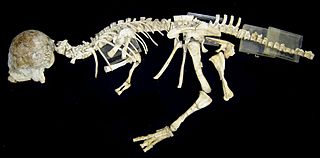
Prenocephale is a genus of small pachycephalosaurid dinosaur from the Late Cretaceous Nemegt Formation of Mongolia. It was similar in many ways to its close relative, Homalocephale.

Mononykus is a genus of alvarezsaurid dinosaur that lived during the Late Cretaceous in what is now Asia on the Nemegt Formation, about 70 million years ago.
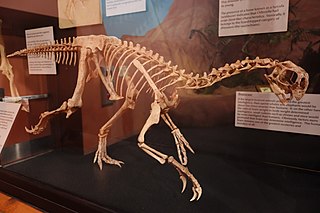
Heyuannia is a genus of oviraptorid dinosaur that lived in Asia during the Late Cretaceous epoch, in what is now China and Mongolia. It was the first oviraptorid found in China; most others were found in neighbouring Mongolia. Two species are known: H. huangi, named by Lü Junchang in 2002 from the Dalangshan Formation; and H. yanshini, originally named as a separate genus Ingenia from the Barun Goyot Formation by Rinchen Barsbold in 1981, and later renamed to Ajancingenia in 2013 due to the preoccupation of Ingenia. The latter name was eventually discarded due to various ethical issues surrounding the author.

Nemegtomaia is a genus of oviraptorid dinosaur from what is now Mongolia that lived in the Late Cretaceous Period, about 70 million years ago. The first specimen was found in 1996, and became the basis of the new genus and species N. barsboldi in 2004. The original genus name was Nemegtia, but this was changed to Nemegtomaia in 2005, as the former name was preoccupied. The first part of the generic name refers to the Nemegt Basin, where the animal was found, and the second part means "good mother", in reference to the fact that oviraptorids are known to have brooded their eggs. The specific name honours the palaeontologist Rinchen Barsbold. Two more specimens were found in 2007, one of which was found on top of a nest with eggs, but the dinosaur had received its genus name before it was found associated with eggs.
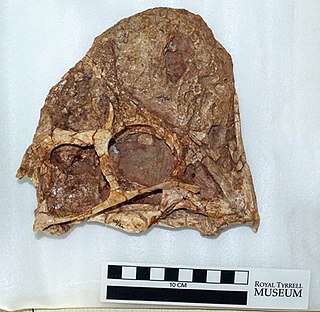
Rinchenia is a genus of oviraptorid dinosaur that lived in Asia during the Late Cretaceous epoch in what is now Mongolia, Nemegt Formation, around 70 million years ago. The type and only known species, Rinchenia mongoliensis, was originally classified as a species within the genus Oviraptor, but a subsequent reexamination found differences significant enough to warrant a separate genus. The name Rinchenia was coined for this new genus, though not formally described in detail.

The Barun Goyot Formation is a geological formation dating to the Late Cretaceous Period. It is located within and is widely represented in the Gobi Desert Basin, in the Ömnögovi Province of Mongolia.

The Nemegt Formation is a geological formation in the Gobi Desert of Mongolia, dating to the Late Cretaceous. The formation consists of river channel sediments and contains fossils of fish, turtles, crocodilians, and a diverse fauna of dinosaurs, including birds.

Ceratonykus is a monospecific genus of alvarezsaurid dinosaur from Mongolia that lived during the Late Cretaceous in what is now the Barun Goyot Formation. The type and only species, Ceratonykus oculatus, is known from a fragmentary skeleton, including an incomplete skull, of an adult individual. It was named and described in 2009 by Vladimir Alifanov and Rinchen Barsbold. Its describers questioned the traditional placement of alvarezsaurs in Theropoda, instead suggesting they were ornithischians, but this has not been accepted since. Ceratonykus has an estimated length of 75 centimetres and weight of 760 grams. It has been considered as a possible junior synonym of Parvicursor.
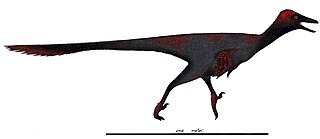
Gobivenator is an extinct genus of troodontid theropod dinosaur known from the late Campanian Djadokhta Formation of central Gobi Desert, Mongolia. It contains a single species, Gobivenator mongoliensis. G. mongoliensis is known from a single individual, which represents the most complete specimen of a Late Cretaceous troodontid currently known.

Aepyornithomimus is a genus of ornithomimid theropod dinosaur from the Late Cretaceous Djadokhta Formation in Mongolia. It lived in the Campanian, around 75 million years ago, when the area is thought to have been a desert. The type and only species is A. tugrikinensis.

Gobiraptor is a genus of oviraptorid maniraptoran dinosaur from the Maastrichtian-age Nemegt Formation of Mongolia. The type and only species is Gobiraptor minutus, known from a single incomplete specimen—the holotype MPC-D 102/111. It has been found not to be closely related to the other oviraptorids it shared its environment with.

Oksoko is a genus of oviraptorid dinosaur from the Late Cretaceous of Asia, that lived in what is now the Nemegt Formation in Mongolia. It includes the type species Oksoko avarsan.
Khulsanurus is an extinct genus of alvarezsaurid theropod dinosaur from the Late Cretaceous Barungoyot Formation of the Khulsan Locality in the Gobi Desert region of Mongolia. The type and only species is Khulsanurus magnificus.

Ondogurvel is a genus of alvarezsaurid dinosaur from the Late Cretaceous (Campanian) Barun Goyot Formation in southern Mongolia. The type and only species is O. alifanovi, known from a partial skeleton consisting of fragments of two last dorsal vertebrae, three anterior sacral vertebrae, right ilium, left and right pubis and ischium, articulated right tibia, fibula, metatarsals II and IV, and phalanges IV-1 and IV-2, right carpometacarpus, left and right manual phalanx II-1, right femur, left pedal phalanx II-1, and fragments of unidentified phalanges.

Natovenator is a genus of halszkaraptorine dromaeosaurid dinosaur from the Late Cretaceous Barun Goyot Formation of Mongolia. The genus is known from a single species, N. polydontus. Natovenator is crucial to the understanding of halszkaraptorines due to it providing more support for the semi-aquatic lifestyle that has been proposed for this clade. This discovery is important as the semi-aquatic lifestyles of halszkaraptorines was contested in early 2022.

Jaculinykus is an extinct genus of alvarezsaurid theropod dinosaur from the Late Cretaceous Baruungoyot Formation of Mongolia. The genus contains a single species, J. yaruui, known from a nearly complete articulated skeleton including bones of the skull. Jaculinykus is notable for its unique hand, which has a hypertrophied first digit and greatly reduced second digit, which is intermediate between the tridactyl hand of Shuvuuia and monodactyl hand of Linhenykus.
